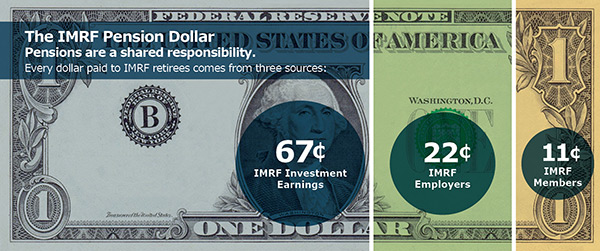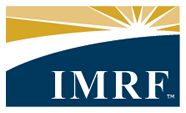IMRF 101 provides a general overview of important topics related to IMRF. Topics covered include IMRF's governance structure, its funding mechanism, information on how IMRF invests its assets, and more.
IMRF Snapshot
- IMRF is not funded by the state of Illinois
- IMRF is not related to local police and fire pension funds
- IMRF is managed by an independent Board of Trustees elected by IMRF employers and members
- IMRF is funded by member and employer contributions and primarily by investment income
- $55.2 billion in assets
- 95.8% funded on an actuarial basis
- More than 524,000 active, inactive, and retired members
- 3,062 participating units of local government
What is IMRF?
IMRF is a "multi-employer public pension fund" that administers a program of disability, retirement, and death benefits for employees of local government in Illinois (excluding the City of Chicago and Cook County). IMRF began operations in 1941. IMRF is governed by Article 7 of the Illinois Pension Code (40 ILCS 5/).
Governance
An independently elected and autonomous Board of Trustees governs IMRF. Four "executive" trustees are elected by employers (participating units of local government), three "employee" trustees are elected by active members, and one "annuitant" trustee is elected by retired members. The IMRF Board does not include any appointed or "ex-officio" trustees.
Board members serve without compensation and are elected to staggered five-year terms. Employee and executive trustees must be active members of IMRF. The annuitant trustee must be receiving an IMRF pension.
Executive Director Brian Collins
Brian Collins has served as executive director since January 2018. Prior to his appointment as executive director, Collins was the Chief Financial Officer for the City of Memphis, Tenn., and spent 30 years working in banking and commercial litigation. A Chicago-native, Collins has a juris doctor degree and a master's in business administration. Collins oversees a staff of 239 and reports directly to the eight-member IMRF board of trustees.
IMRF Funding
IMRF is not funded by the state of Illinois. IMRF is funded by three sources: employee contributions, employer contributions, and investment returns. Investment returns fund the greatest portion of pension costs: more than 60 percent.
As of December 31, 2024, IMRF had more than $55.2 billion under management. These assets are held in trust; they are not public money to be spent for any other purpose other than for IMRF members' disability, retirement, and death benefits.
Each IMRF employer builds its own account to fund the pension benefits of its own employees. Each IMRF employer has its own unique contribution rate, which is calculated annually. An employer's contribution rate is based upon its employees' salaries, ages, years of service credit, etc., as well the return on IMRF's investments.
Most IMRF members participate in the Regular plan; these members contribute 4.5% of their salary toward their future pension. Members do not contribute toward the cost of their IMRF disability or death benefits.
Investment Returns and the Impact on Employers
IMRF employer rates are on a "two-year lag." For example, IMRF sent 2024 information to its external actuaries in 2025, and the actuaries used that information to calculate the 2026 employer contribution rates.
The portfolio’s 2024 rate of return was 9.2%, after investment management fees.
IMRF Investment of Assets
Unlike a private investor who has a limited investment timeline, such as 10, 20, or 30 years, IMRF has an infinite investment time horizon. We are investing for the 20-year-old who joined IMRF today, as well as the 67-year-old who will retire later this year.
IMRF hires and monitors dozens of professional firms that invest IMRF assets. Our diversified investment strategy results in steady and responsible returns. IMRF investments include both U.S. and international stock; fixed income; real estate; and alternative investments like private equity, agriculture, and timberland. IMRF also holds cash in reserve to fund benefit payments.
The Full Funding Goal
IMRF's goal is to be 100% funded, which means we have all the money on hand that we will ever need to pay for the benefits of current and future retirees. IMRF is about 95.8% funded, which makes IMRF the best-funded statewide retirement system in Illinois. We were about 100% funded prior to the recession, and our long-term goal is to reach 100% funded status. Our "annuitant reserve," the account IMRF uses to pay benefits to current retirees, is always kept 100% funded.

Achieving 100% funding status is good public policy. Studies have shown that better funded plans earn higher returns on their investments. Higher returns on investments translate to lower employer contribution rates and less cost to taxpayers. With full funding, current taxpayers pay for the benefits of municipal workers that are providing services to them. If a plan is underfunded, future generations must pay for the benefits of municipal workers that are no longer providing municipal services.
IMRF Participants
As of December 31, 2024, 3,062 units of local government participated in IMRF. Government types include cities (not Chicago), villages, townships, school districts (not the certified staff), counties (not Cook), fire protection districts, library districts, park districts, and more.
As of December 31, 2024, 196,859 active members, 169,066 inactive members, and 158,379 retirees participated in IMRF.
The IMRF Pension
Most IMRF members participate in IMRF's Regular plan. A Regular Tier 1 member needs at least eight years to vest (be eligible) to receive an IMRF Regular plan pension. The earliest age a Regular Tier 1 member can receive a pension is age 55 (reduced) and age 60 (full pension).
On April 14, 2010, the governor signed Senate Bill 1946 (Public Act 96-0889). This law created a second tier of IMRF benefits for members who are first enrolled in IMRF's Regular Plan on or after January 1, 2011.
The earliest age a Regular Tier 2 member can receive a pension is age 62 (reduced) and age 67 (full pension) The pension amount is calculated by a formula that includes the member's years of service credit and an average of the member's final salary.
This new law does not affect members currently participating in IMRF or members who ever participated in IMRF or in a reciprocal system prior to the effective date of this legislation. These members remain in Tier 1.
This new law made no changes to benefits payable to current or future members of IMRF's Sheriff's Law Enforcement Personnel (SLEP) plan.
Tier 2 lowers the cost of an IMRF pension and saves money for Illinois taxpayers. The cost to provide a Tier 2 Regular Plan IMRF pension is 45% less than a Tier 1 Regular Plan IMRF pension. More than 215,000 IMRF members participate in Tier 2.
IMRF is established by Article 7 of the Illinois Pension Code (40 ILCS 5/7). To change IMRF's benefits, the Illinois General Assembly must pass legislation changing the Pension Code.

